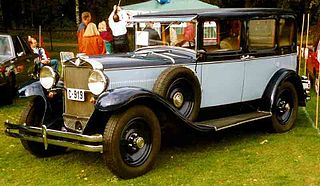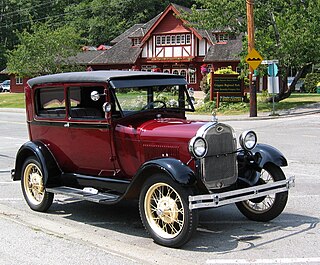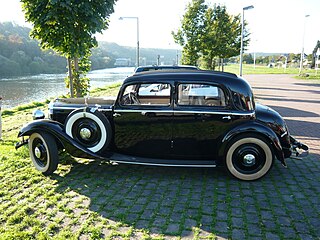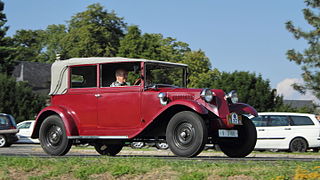
The 508 Balilla was a compact car designed and developed by Fiat in 1932. It was, effectively, the replacement of the Fiat 509, although production of the earlier model had ceased back in 1929. It had a three-speed transmission, seated four, and had a top speed of about 50 mph (80 km/h). It sold for 10,800 lire. About 113,000 were produced.

Zbrojovka Brno, s.r.o is a maker of small arms in Brno, Czechoslovakia, wholly owned by Colt-CZ Group. In the past it also made light artillery, cars, motorcycles, tractors and various tools, such as typewriters and early computers.

The Fiat 524 is a car which was produced by Italian automotive manufacturer Fiat between 1931 and 1934. The 524 was a bigger and more luxurious version of the Fiat 522 model. 10,135 cars were produced in total.

The Fiat 514 is a model of car produced by the Italian automotive company, Fiat between 1929 and 1932.

The Ford Model A was the Ford Motor Company's second market success, replacing the venerable Model T which had been produced for 18 years. It was first produced on October 20, 1927, but not introduced until December 2. This new Model A was designated a 1928 model and was available in four standard colors.

Walter Aircraft Engines is an aircraft engine manufacturer and former automotive manufacturer. Its notable products include the M601 turboprop. The company is based in Prague, Czech Republic. It has been a subsidiary of GE Aerospace since July 2008.

The Tatra 80 is a Czechoslovak luxury full-size car built by Tatra between 1931 and 1935.

The Western Antique Aeroplane and Automobile Museum (WAAAM) is located in Hood River, Oregon, United States, adjacent to the Ken Jernstedt Memorial Airport. WAAAM is a nonprofit 501(c)(3) organization committed to the preservation of, and education about aviation, automobile, and other historic transportation-related relics.

The Tatra 70 is a Czechoslovak luxury car that was made by Tatra at Kopřivnice from 1931 to 1937. It succeeded the Tatra 31.

The Mercedes-Benz W15 is an automobile produced by Mercedes-Benz from 1931 to 1936. Regarded today as a mid-size family car, it was given the chassis designation W15, and sold as the Typ 170 in four-door "Limousine" (sedan/saloon) and Cabriolet forms.

The DKW Typ 4=8 is a small rear-wheel drive two-stroke V4 engined car produced at the company's Spandau plant by DKW. It was launched at the Berlin Motor-show in 1929 as a successor to the DKW Typ P built at the same factory, although the DKW Typ P 4=8 was significantly larger than the Typ P: in terms of market positioning a more direct successor to the DKW Type P was probably the DKW F1 produced in Zwickau from 1931.
The Adler Standard 8 is a large passenger car introduced in 1928 by the Frankfurt auto-maker, Adler. It was a big eight cylinder “limousine” (saloon) closely modelled on the manufacturer’s Standard 6 which had first appeared in public in October 1926. However the Standard 8 had a longer 3,325 mm (130.9 in) wheelbase as well as a 50 mm (2.0 in) wider track. Although it closely resembled the Standard 6, the Standard 8 was larger all round. The Standard 8 engine had eight cylinders, but individually the cylinder dimensions, at 75 mm (3.0 in) x 110 mm (4.3 in), were identical to those on the six cylinder car as well as on the four cylinder with the Adler Favorit which appeared in 1929.

The Adler Trumpf is a small family car introduced by the Frankfurt based auto-maker, Adler in March 1932, with Trumpf production fully starting in the late summer that year. In a move reminiscent of British Leyland in the 1970s, Adler launched two similarly sized cars in the same year, one of which followed the 1931 DKW F1's then innovative front-wheel drive layout, and the other model using the conventional rear-wheel drive configuration still used by then market leader, Opel's 1.2 litre 'model 6'.

The Opel 1,2 Liter is a small car manufactured by Opel between 1931 and 1935. The 1,2 Liter was replaced in 1935 by the Opel P4 which was broadly similar but employed a new engine and continued in production until December 1937. For just one year, in 1933, the manufacturer also offered the Opel 1,0 Liter which was a smaller engined version of the 1,2 Liter. The Opel 1,2 Liter replaced the last version of the Opel Laubfrosch and was itself first complemented and then effectively replaced by the more roomy Opel Kadett, which had itself already entered production in 1935.

The Mercedes-Benz W 21 was a six-cylinder passenger car launched in 1933 using the name Mercedes-Benz Typ 200. It was one of several Mercedes-Benz models known, in its own time, as the Mercedes-Benz 200 and is therefore in retrospect more commonly referred to using its Mercedes-Benz works number, “W21”.

The Packard Eight was a luxury automobile produced by Packard between 1924 and 1936, and was an all new platform that took the top market position from the earlier Packard Twin Six which was first introduced in 1916. When it was introduced, it was designated as the junior Packard until the company ended in the late 1950s.

The Nervastella is a large automobile constructed by Renault between 1930 and 1937. It was used as a state car and pictures of the president of the French Republic sitting in a Nervastella can therefore be seen in newsreels from the mid-1930s.
The Škoda 637 is a Czechoslovak mid-size car that was made by Škoda from 1932 to 1935.

The Tatra 52 is a Czechoslovak mid-size car that was made by Závody Tatra from 1931 to 1939. It was built both at the Tatra factory in Kopřivnice and also under licence at Frankfurt am Main in Germany.

The Zbrojovka Z 9 was a car produced by Československá Zbrojovka in the 1930s. First shown in 1929, the car had a conventional design, with a liquid-cooled two cylinder two stroke mounted at the front driving the rear wheels. In addition to a four door open top phaeton body, the car was also produced as a two-door to order, as both a roadster and a sedan, and a doorless pickup. In 1931, one car was raced 10,255 km (6,372 mi) across Europe, while another participated in the Monte Carlo Rally, although it did not finish. Production ran until 1932, with a total of 850 produced.













































